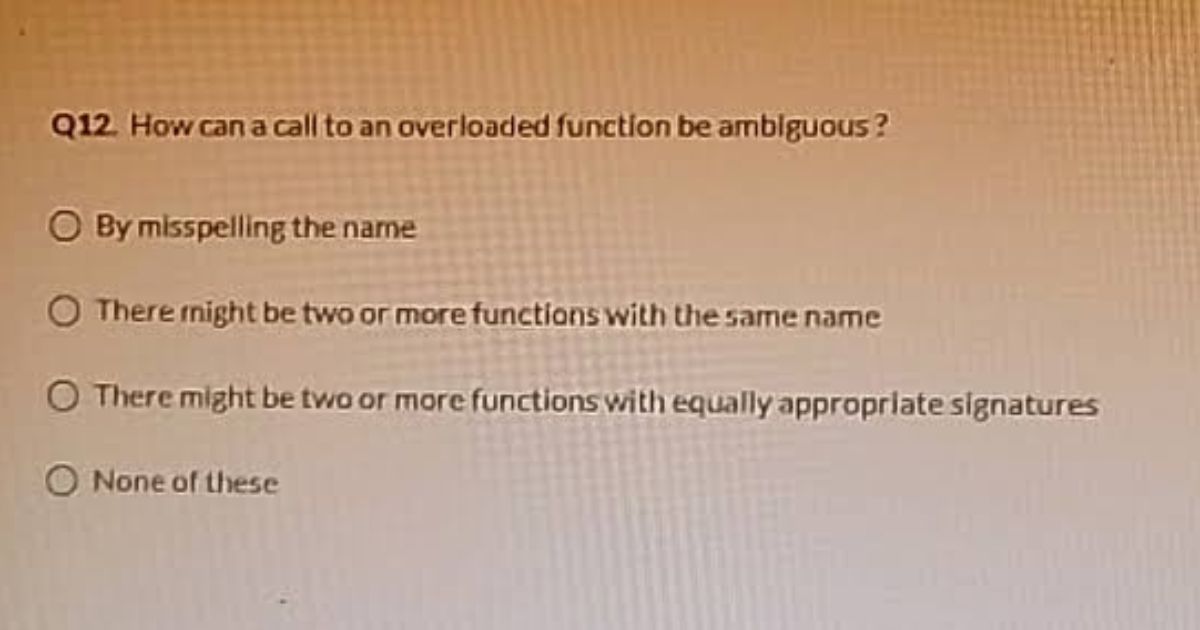
Introduction
Function overloading allows you to define multiple functions with the same name but different parameter types. This makes it possible to use a single function name for related operations. However, ambiguity arises when the compiler cannot determine which overloaded function is the best match for a given call. In this article, we explore how such ambiguity occurs, what factors contribute to it, and provide a concrete example to illustrate the issue.
How Overload Resolution Works
When you call an overloaded function, the compiler follows these general steps to select the best match:
- Identify Viable Candidates:
The compiler gathers all functions with the same name that could potentially be called with the provided arguments. - Rank Conversion Sequences:
For each candidate, the compiler determines how each argument must be converted to match the parameter types. It ranks these conversion sequences based on their closeness to an exact match. Conversions are categorized as:- Exact Match: No conversion is needed.
- Promotion: Standard conversions like
inttolong(if they are considered promotions). - Conversion: User-defined conversions or other standard conversions that are less preferred.
- Select the Best Match:
The function whose arguments require the least (and best-ranked) conversions is chosen. However, if two or more functions have conversion sequences that are equally good, the call is ambiguous.
When Overload Calls Become Ambiguous
An overloaded function call becomes ambiguous when:
- Multiple Conversions Are Equally Good:
If two or more candidate functions require user-defined conversions or standard conversions that are ranked equally, the compiler cannot decide which one is better. - No Unique Best Match Exists:
The rules of overload resolution mandate that there must be a unique best match. If the comparison does not yield one, the compiler reports an ambiguity error.
A Concrete Example
Consider the following code snippet:
#include <iostream>
struct A {
A(int) {} // User-defined conversion from int to A
};
struct B {
B(int) {} // User-defined conversion from int to B
};
void f(A a) {
std::cout << "Called f(A)\n";
}
void f(B b) {
std::cout << "Called f(B)\n";
}
int main() {
f(10); // Ambiguous call: 10 can be converted to either A or B.
return 0;
}
Explanation
- Two Viable Conversions:
The literal10is of typeintand can be converted to bothAandBusing their respective constructors. Both conversions are user-defined and are equally ranked by the compiler. - No Preferred Conversion:
Since neither conversion is better than the other, the compiler cannot uniquely determine which version offto call. - Ambiguity Error:
As a result, the call tof(10)is ambiguous, and the compiler will generate an error message indicating that the call is ambiguous.
Key Takeaways
- Equal Conversion Ranking:
Ambiguity arises when multiple overloaded functions are equally suitable due to identical conversion sequences. - Compiler Error:
If no unique best match is found, the compiler issues an ambiguity error, requiring you to resolve the conflict by changing the function signatures or providing additional type information. - Design Consideration:
When designing overloaded functions, be mindful of potential ambiguities by ensuring that the conversions needed for each overload are distinct enough to guide the compiler to a unique choice.
Conclusion
A call to an overloaded function can be ambiguous when the provided argument(s) can be converted to match two or more function signatures with equally ranked conversion sequences. The example with structures A and B demonstrates how an integer literal can lead to ambiguity when both conversions are available and equally viable. Understanding these nuances of overload resolution helps in designing clearer interfaces and avoiding ambiguous function calls.
Disclaimer: This article is for informational purposes only and is based on C++ overload resolution rules as specified in the ISO C++ standard.
Also Check:
• How Many Instances Can Be Created for an Abstract Class? An In-Depth Explanation
• Can There Be Mitosis Without DNA Replication in S Phase? Exploring the Cell Cycle Fundamentals
• Where Can You Find the TCS Process for Business Continuity Management?
• Can IAS Officer Do Business? Understanding the Rules and Boundaries



